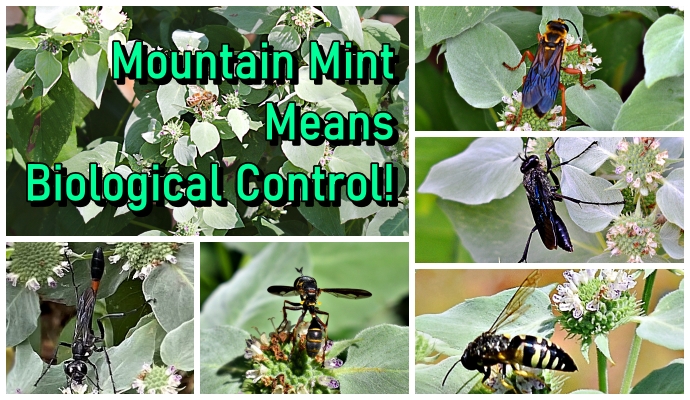If you are inclined to think about protecting your plants with chemical warfare, I invite you to have a paradigm shift to biological warfare. Get nature on your side. You have heard all the reasons not to spray ad nauseum:
• it harms the environment
• it kills caterpillars which are baby bird food
• it kills butterflies
• it is hazardous to our health
• it is hazardous to pets
• nag, nag, nag, nag, nag!
But what are you supposed to do when trying to sleep in bed at night? You can almost hear the little monsters (you know the monster in Alien was based on insects!) chomping away at your plants?!
I say, invite in their enemies, something that will chomp away at them! Biological warfare is the way to go—plant mountain mint. Yes, pollinators love it, but more importantly, “beneficial insects” love it. “Beneficial” is a blanket term to cover all the critters that aren’t butterflies, bees, or moths. In this case, we are talking WASPS! Yes, I said wasps; predators, carnivores, attack weapons against aphids, beetles, armyworms, and anything else munching on your plants.
Don’t run screaming like a little sissy; this is warfare! First of all, the wasps have no interest in you, don’t grab them, and you don’t get stung. I got within two inches of them to take their pictures, and they could not have cared less. All they cared about was the pollen and nectar of the mountain mint. What? They have babies too. They feed pollen and nectar to their young; a beetle is not wasp baby food. In a half-hour, I took pictures of thirteen different pollinators, one honeybee, four native bees, one fly, and the rest were wasps. Some more critters were too fast for me to photograph.
Mountain mint is not the most beautiful plant, but it is pleasant enough and has a long bloom period, a month or more in July. Mine is clustered mountain mint Pycnanthemum muticum; it grows in full sun to shade; it is an herbaceous perennial and, as a bonus, is deer resistant! The leaves have a strong minty odor when crushed. It grows in fertile, moist to medium moisture, well-drained soils. It reproduces by seed or rhizomes. If you don’t want it to spread, prune the roots in the spring or divide and pass offshoots to a friend.
If you are worried about your plants before and after the mountain mint bloom period, don’t. Below is a list of plants that may meet your needs. What you are looking for in our biological warfare against plant-eating critters are plants classified as CBC plants, Conservation Biological Control. For descriptions and growth requirements, you can go to the NCSU Gardeners Toolbox (https://plants.ces.ncsu.edu) or the Johnson Wildflower Center (https://www.wildflower.org). Once you have your CBC plants established, you can sleep at peace at night knowing you have Mother Nature on your side, and you are on her side as well.
The Earth Friendly Alternative to Insecticides: Native Plants
That Support Conservation Biological Control in Georgia
CBC plant – A plant that attracts predatory or parasitoid insects that prey upon pest insects.
Beneficial insects need shelter and another food source in their diet, such as the sugars from flowers to mature their eggs. Parasitoids lay their eggs on caterpillars which will hatch and kill them. Other beneficials will lay their eggs on plants; the larvae hatch and feed on pests.
• Use a wide variety of attractive plants. Plants that flower at different times of the year can provide beneficials nectar and pollen when they need it.
• Plantings at least four feet by four feet of each variety work best at attracting beneficials.
• A bird bath or backyard water feature not only attracts birds (another predator of insects) but also attracts beneficials.
• Tolerate minor pest infestations. The beneficial insects will get the memo before you do. This will provide another food source for the beneficials and help keep them in your yard.
• Trees
• Cornus florida (Flowering dogwood)
• Crataegus mollis (Downy hawthorn)
• Prunus serotina (Black cherry)
• Salix nigra (Black willow)
• Tilia americana (American basswood)
• Shrubs
• Ceanothus americanus (New Jersey tea)
• Salix cordata (Heartleaf willow)
• Viburnum dentatum (Southern arrowwood)
• Viburnum prunifolium (Blackhaw)
• Forbs
• Achillea millefolium (Common yarrow)
• Ageratina altissima (White snakeroot)
• Allium cernuum (Nodding onion)
• Angelica venenosa (Harry Angelica)
• Antennaria plantaginifolia (Woman’s tobacco)
• Apocynum androsaemifolium (Spreading dogbane)
• Apocynum cannabinum (Indian hemp)
• Arnoglossum atriplicifolium (Pale indian plantain)
• Bidens aristosa (Bearded beggarticks)
• Bidens laevis (Smooth beggartick)
• Chamaecrista fasciculata (Partridge pea)
• Cicuta maculata (Spotted water hemlock)
• Comandra umbellata (Bastard toadflax)
• Conoclinium coelestinum (Blue mistflower)
• Coreopsis lanceolata (Lanceleaf coreopsis)
• Eriogonum tomentosum (Dog-tongue Buckwheat)
• Eryngium yuccifolium (Rattlesnake master)
• Eupatorium perfoliatum (Common boneset)
• Heliopsis helianthoides (Smooth oxeye)
• Heracleum maximum (Common cow parsnip)
• Krigia biflora (Two-flower dwarf dandelion)
• Lobelia siphilitica (Great blue lobelia)
• Monarda punctata (Spotted beebalm)
• Oxypolis rigidior (Stiff cowbane)
• Pseudognaphalium obtusifolium (Sweet
everlasting)
• Ranunculus fascicularis (Early buttercup)
• Silphium perfoliatum (Cup plant)
• Sium suave (Hemlock waterparsnip)
• Symphyotrichum lateriflorum var. lateriflorum
(Calico aster)(the only aster)
• Veronicastrum virginicum (Culver’s root)
• Zizia aptera (Heart-leaved meadow parsnip)
• Zizia aurea (Golden zizia)
• Whole Genera
• Asclepias genus (milkweeds spp.)
• Erigeron genus (fleabane spp.)
• Pycnanthemum genus (most mountain mints)
• Rhus genus (most sumacs)
• Sambucus genus (most elderberries)
• Solidago genus (Goldenrod spp.)
• References:
• https://www.wildflower.org/plants/
• https://permaculturenews.org/2014/10/04/plants-attract-beneficial-insects/https://crawford.tardigrade.net/bugs/BugofMonth09.html

